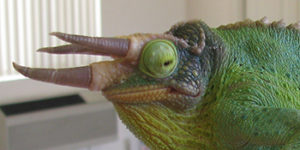Summary:
- Some species, such as Jackson’s Chameleons, give live birth
- Female Jackson’s Chameleons can retain sperm for longer than a year so they are able to produce babies even though they have not been with a male for a long time.
- The babies are delicate, but designed to survive if you provide the correct conditions.
- This podcast episode is about how to provide those conditions quickly. More permanent arrangements are for later,
- Get ready for a crash course in chameleon baby care!
One of the most common shocks for people getting into chameleons is the ones that knowingly, or unknowingly, get a live bearing female chameleon. Having only one chameleon and no intention of breeding they are surprised one day by looking into the cage and seeing babies all over. There is a moment of complete fascination towards what are the world’s cutest little dragons!



But then the fascination is replaced by panic. How in the world do you take care of these little thing? What do they even eat that small?!?!
On one hand, there is very specialized care that needs to be given. On the other hand, these little babies were designed to survive in a world that just wants to eat them. We will go over what is important for you to give them to allow them to use those survival skills to grow up.
This is such a common occurrence that it was one of the first podcast episodes I recorded.
Introduction: How Did This Happen?
Most chameleon species are egg laying, but a surprising number are actually live bearing. This is an adaptation for chameleons that live in the higher altitudes and experience cooler temperatures. The ability to incubate the eggs inside the mother’s body allows her to move the eggs into the sunlight and warm them up even though it is cold out. With a gravid female Jackson’s chameleon you can see her sunning her belly.
The most common live bearing chameleon is the Jackson’s Chameleon. Though we have seen imports of Trioceros hoehnelii from Kenya that is live bearing as well. There are a number of live bearers from Tanzania, but these have not been exported for many years. But, usually, if a person is surprised by babies it will be from a Jackson’s Chameleon. This situation happens quite often because Jackson’s Chameleons have another trick up their sleeve. The females can produce multiple groups of babies from one mating and can postpone fertilization. This means that you can have a single female Jackson’s Chameleon and two years after you bring her home from a reptile show she can give birth. And this is probably where you are right now. You came down the stairs and were greeted with 25 sets of chameleon eyes instead of the one set you said good night to!
Ideally, we prepare for babies for months with the proper housing and small food. But today, we will do what we can with what we can throw together at a moment’s notice!

The female Jackson’s Chameleon is the one chameleon responsible for the most panic in the chameleon world! She is also the one most responsible for creating the most life long chameleon passions. Once you raise up a brood of these baby prehistoric tree dragons you have experienced something few people can claim.

When you discover babies in your chameleon cage you will be led on a spirited chase to find them all! It usually takes me until the next day to get them all!

This is how babies hit the ground. They then break out of their birthing sacs and scamper away. Some babies are not strong enough to escape these sacs. Some keepers help the baby out and some respect that not all babies were meant to survive. The choice is yours. Often there is nothing you can do. If you come home and find babies like this then they probably were not strong enough to live. This can be from a number of different causes. It is very difficult to determine if it was something in nutrition or environmental conditions.
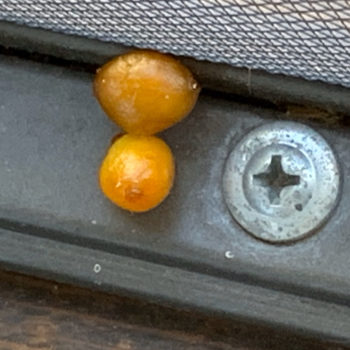
Bright yellow or orange spheres are unfertilized ova that were expelled. It is normal to see these and there is nothing to be concerned about. When producing a brood from retained sperm, fewer babies are created and the chances of unfertilized ova increase.
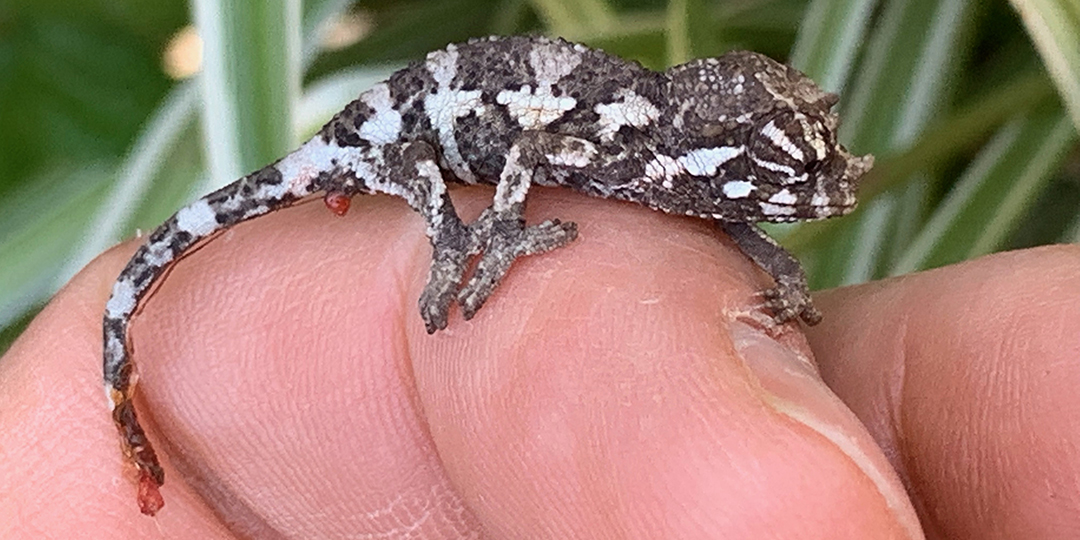
You may see what looks like bloody tails and appendages on the babies. This is actually tissue from the birthing sac. You can gently help the baby get rid of these. If they dry then it is difficult to get off. A wet Q-Tip can be used if it dries on the skin, but proceed with caution that you do not rip their skin with being too rough.
1) Remove the Babies From the Mother's Cage
You do want to remove the babies from the mother’s cage. There is a certain amount of time where her hunger is turned off to give the babies a chance to disperse. So you do not have to panic and can leisurely remove the babies as they are born. If you have come home from work and she is obviously done giving birth (usually giving birth happens in the morning) then it is a good idea to move the female out of the cage to allow you to thoroughly search the cage for babies. When they are initially born it is easy to see as their first instinct is to disperse as far as possible. So you will see babies crawling the screen walls (assuming there is a screen wall). But if they could not get out and you find them hours later then they will have retreated back into the foliage and you will have a project finding them all! Even when I catch the final minutes of her giving birth I end up finding babies over the next day or so!
I have never seen or heard of a female eating one of her babies. But they are eating size and I know of no one yet that has tested how long the babies are protected by whatever hormone turns off the hunger drive in the mother.
Note: I have made an assumptions here that you are keeping the female in her own cage and there is no male around. If you are keeping Jackson’s Chameleons as a pair then remove the babies before they are eaten by the male and remove the female into her own cage permanently.
2) Creating a Temporary Baby Chameleon Cage
When surprised by babies you’ll need some place to put them. These things crawl the tiniest ridges so getting something that can contain them can be tricky. Whatever you decide on, you place leafy plants in it and thin branches. Here are a couple of very quick ideas to consider in a pinch while you get the permanent residence put together.
- The Bath Tub. Perhaps the most available container is a bath tub or shower stall. Place a couple of potted plants in the middle, make sure the drain is plugged, make sure there is no water on the floor, and have a network of branches thrown in. The babies will probably still be in the scatter mode and you will have them in all corners of the tub or stall. Therefore be very careful when opening any door. The babies will be everywhere. But, with the plants and branches, they will, at least, have the option of being a good citizen.
- Tupperware. Babies can be placed in plastic kitchen ware. They need some branches and leaves, but make extra sure that they cannot reach the edge of the container. It is amazing how they can stretch.
- Plastic Sweater Boxes. Sterilite tubs are, perhaps, the most popular containers to keep babies in. They are relatively large and have high sides. Many breeders use these as their permanent baby raising containers.
- Screen Cage from the pet store. The chameleon community often has little good to say about the ZooMed Chameleon Kit, but it has the advantage that it is widely assorted in the mass market and small business retail pet stores. I once had three rare baby Meller’s Chameleons and unexpectedly had to take my car in for service eight hours away from home. A quick trip to the home improvement store nursery and then the pet store had me spending the night with my Meller’s Chameleon babies in a planted Zoo Med Chameleon Kit. It worked great for a temporary baby cage! So, the babies were not a surprise, but having to house them was so I found myself in almost the same situation you are! (Albeit, with only three babies…you probably have 8 to 30!)
Whatever container you are able to put together, be very careful of the babies being able to climb the sides or reach the edges to crawl out.

Here is a standard baby bin. There is a plant in the middle and network branches all around so if the baby falls it can climb back up. Babies do not fall unless they try to stretch to escape their bin. They will try this so just have the branches that lead from the bottom to the plant. I also have a food dish with branches near by for the chameleon to pick off the flies.

You will need multiple bins to continually separate babies that are bullying each other. Ideally, you will have one bin per baby. Often this is not feasible for people so create as many bins as possible.
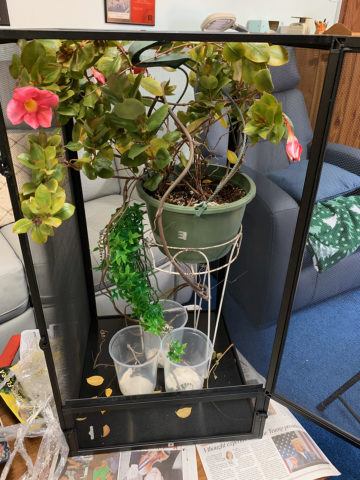
Another emergency option is to rush down to the pet store and pick up a Zoo Med Chameleon Kit. Put a plant in the middle and you will have a very quick baby cage solution. This cage has the advantage that it is enclosed and you will not have to worry about escapees!
3) Feeding a Brood of Ravenous Baby Tree Dragons
Very quickly you will need to procure food for the babies. They are born with enough calories to get them through a day or two. They may even refuse the eat for a day. But, very soon, they will be looking for food. The most common food items that can usually be found are fruit flies and pinhead crickets. Standard pet stores may not carry these items, but online you can find fruit flies, bean beetles, and pin head crickets. There are two types of fruit flies. The larger is Drosophila hydei and the smaller one is D. melanogaster. With baby Jackson’s Chameleons you can use either one. The one trick is to ask the supplier if they are “blooming” or “producing”. Since fruit flies take weeks to hatch and get to the stage where they can be eaten you need to know how new the fruit fly culture is. If the culture is producing then the fruit flies have hatched and they can be fed when you get the culture. It would be best to call in the order instead of doing it online as you can talk to someone and have them verify that the culture is producing. If they have none producing it is not a bad idea to get it anyways as you will need many fruit flies in the coming weeks, but it does mean that you need you find a more immediate solution as well.
If you are lucky enough to be in an area and season where you have wild fruit flies around you the feeding becomes as easy as putting put a cup with fruit in it. Fruit flies will come on their own and provide a tasty feeding dish for your chameleons. If you don’t know if you have wild fruit flies around you just leave out a slice of banana or orange and see if any flies start crawling around it the next day.
Crickets are available from many sources and at many different sizes. Order 1000 pin head crickets and you will be set with food that you can feed right away. A good estimate on how much to plan for is ten food items a day per baby. This gives you a little buffer to account for escapees and feeder deaths. So expect to be buying 1000 crickets every five days for a 20 baby litter.
For babies you feed them as much as they will eat so it is fine to make sure there is always food available. Obesity is not a consideration until much later.
As far as supplementation, many breeders wait a couple of weeks before they start supplementing. I start with plain calcium or Arcadia EarthPro-A which does not have fat soluble vitamins. Jackson’s Chameleons are sensitive to supplementations so I stay away from vitamin D3 and vitamin A until later.
Read the section on gut loading to ensure your feeders are of top nutritional value. But this is something you can reference once you have the food items on order. We are still in panic mode here! At the end I will list some links to brush up on some important aspects of care.
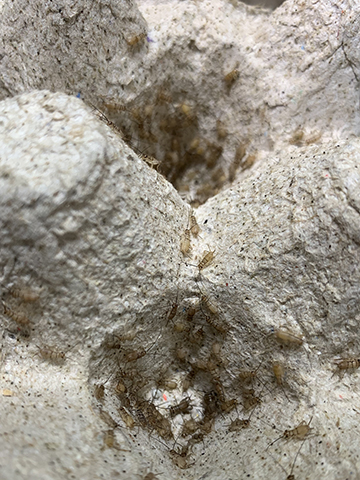
Crickets are commonly offered by many online providers. The cost of shipping makes them expensive but they are a reliable option in a panic situation.

Bean beetles are a popular chameleon baby food and are easy to breed on your own. Though creating your own feeder breeding project is usually most effective when you are expecting babies due to how long it takes to get up and running.

Fruit flies are commonly offered. All those black shapes on the top are the holy grail as those are hatched fruit flies and can feed babies immediately.

Keeping fruit flies in the open cage isn’t that difficult if you include a fruit cup. eating fruit is a fruit flies greatest goal in life. Give them fruit and they have no reason to go anywhere else.
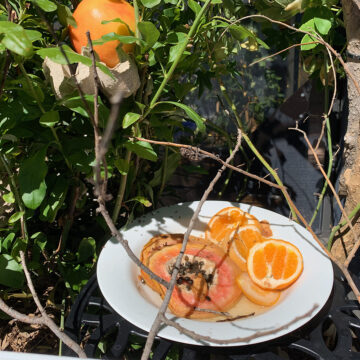
If you live in an area that has wild fruit flies your job to provide food for baby chameleons has suddenly gotten much easier. Putting out a bowl of fruit and keeping it moist is all you have to do and the wild fruit flies will take care of the rest.

A single orange can provide a self-contained fruit fly feeding station which will be much easier to keep moist.
Breed Your Own Fruit Flies
While you are trying to attract the wild fruit flies, it is worth getting flightless fruitflies in and starting your own colonies. This will take some weeks to get started, but you will be happy for having a supply of food you can control. This video shows you how to make your own fruit fly cultures so you do not have to constantly buy them.
4) Conditions to Raise Up Baby Live Bearing Chameleons
Jackson’s Chameleon babies will be looking for temperatures in the low to mid 70s with a basking warm-up spot of about 80. I encourage lower temperatures than adults because we are dealing with smaller areas. Over the night time they will want at least a 10 to 15 degree temperature drop. Humidity would be below 30-50% during the day and 75%-100% at night to maintain a natural humidity cycle. I shoot for a UVB level of UVI 1-2 up to UVI 3. Within a small space this can be generated by a Arcadia T8 6% or Reptisun T8 5.0 linear fluorescent bulb. A 48″ fixture can cover multiple bins. Just mount it 6″ above the basking branches. Note that if you do not have screen that the UVB level charts in the section on setting up UVB cannot be used as those are all through screen. Without screen the UVB levels are about 50% higher.
Jackson’s chameleons have a reputation for being sensitive and dying mysteriously at around three months old. Some breeders experience this and some do not. We are still trying to determine what the cause is. The most likely cause is either not enough nighttime drop or cohabitation stress. I, personally, believe it to be most often caused by housing babies together. Jackson’s babies do not like to be housed together and they do not show stress as dramatically as panthers or veileds do so the signs are often missed. This is my hypothesis as to why they appear to “suddenly without warning” die. If you have the option, raising your babies either separately or in a large enough, well planted cage will reduce the stress.
5) Hydration
Hydrating babies is best done with a fine hand mister. You need wide coverage that is gentle and you can best provide that with a hand mister. I use a hand mister for my babies and mist just before the lights come on. This way the babies wake up to a layer of dew on the leaves. When I mist them at night they are asleep and will not react in a panic like chameleons do when they are sprayed. Night time fogging as described in the natural hydration method will provide suitable hydration without overwhelming the babies.
Beware of puddles on the ground as there is a chance of babies drowning themselves if they get stuck in a puddle. It is rare but it has happened to me.
6) What Do I Do With a Bunch of Baby Chameleons?
The babies are safe for the moment and mother is in recovery. Now is the time to figure out what you want to do with the babies. You have two options: Keep them and raise them up or give them away. Selling them is not a good option as they shouldn’t be sold until they are about four months old. If you decide this whole baby thing was not what you signed up for and want to give them to someone who can take care of them better than you then you can find chameleon people in your area by hopping onto chameleon themed Facebook pages or the chameleon forums (at chameleonforums.com) and sharing your situation. Raising up baby chameleons is a challenge. If you are giving them away I suggest finding someone experienced at those mentioned locations. The sooner you can pass them to an experienced chameleon person the better. Resist handing them out to inexperienced family members or co-workers. They are cute, but unless any of them happen to have fruit fly cultures going this probably relegates the babies to a short life. If you give them away then your action item list stops here. If you elect to raise them up then this action item list gets a bit longer! Luckily, that is exactly what this website is for. Start at Chameleon Basics and follow the coursework!
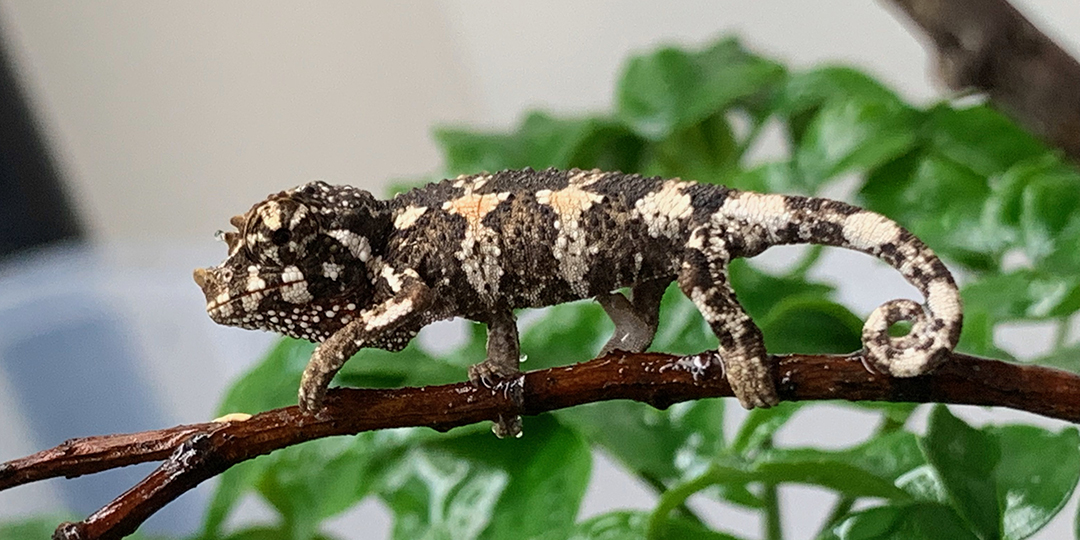
Transcript of the podcast:
The podcast episode available above was written specifically for owners that were surprised by baby chameleons. If you would like to review any of the information or would rather read instead of listen, the transcript of the entire podcast is below.
Transcript: Today’s episode is titled Surprise! Chameleon Babies!! Yay!…Yikes!! In honor of all the emotions we go through when baby chameleons hatch or are born. But, you ask, what is the Yikes in there for? Aren’t breeders all prepared for hatch date? Perhaps, but then there are the ones that are surprised by eggs hatching two months before estimated hatch date and then there are the livebearers that can give birth at any inconvenient time – such as 9 months after you have brought back a single female Jackson’s chameleon from the show with no intention of ever breeding her and you walk down the stairs one morning and instead of a nice cup of Chameleon Cold Brew waiting for you, you find a cage full of baby chameleons and one tired momma. Whoa! Talk about needing to find an accelerated crash course in baby chameleon care! So this is where we will start. Experienced breeders or even first time breeders who have researched baby care may end up surprised, but they at least know exactly what they need to do quickly. I am going to start off at the level of the person who doesn’t even know if the babies should be separated from their mother!
So let’s set the ideal scenario first. A prepared breeder will have caging ready long before hatch date. In fact they have purchased everything they need right about when the eggs were laid or the live bearer was bred. Half way into the incubation they started their fruit fly cultures to make sure the when the babies hatched out there would be plenty of food immediately available. And then it is just a waiting game for that joyous moment.
The scenario furthest from ideal is the family with their first chameleon enjoying learning about UVB and whose biggest challenge right now is deciding whether to let dubia cockroach feeders in the house coming face to face with 20 little aliens who have invaded their chameleon cage. Guess what, my fellow chameleon wranglers? Some chameleons are livebearers! And you know what is really cool? They have developed the ability to store sperm and impregnate themselves at a later date! So, no, you don’t have to have a male in your single chameleon household to have babies! Ain’t nature grand!
So, let’s talk about the basics of chameleon babyhood. First of all, most chameleons lay eggs, but there are respectable number that have live birth. Ones that are easy to find at the time of this podcast are Jackson’s Chameleons, Trioceros sternfeldi, Trioceros wernerii, and South African Bradypodion. Live birth is thought to be an adaptation of chameleons that live in areas that experience cold weather and so allows the chameleon to be more in control of the babies’ development conditions. The mother can bask to warm everything up. Chameleons are born/hatched fully ready to go out into the world as an independent bug exterminator. Neither egg hatched babies nor live birthed babies have a relationship with their mother. Both versions come into the world with their stomachs full which gives them a day or two to get orientated before they need to start eating. Chameleons disperse and find their own way about the world so, ideally, they would all be raised individually. But the sibling aggression usually starts out low and the competition between babies does not get overly physical for a month or two. There’s your ten sentence summary. Let’s get into actionable steps.
Let’s use the scenario of having a single female Jackson’s chameleon who has given birth to a surprise litter of 20 babies. So you walk downstairs and are greeted with 20 baby chameleons. First, take a second to be completely amazed at these incredible creatures! Chameleon babies are the cutest things ever! Next, we want to prepare a place for these little guys. The mothers do not seem to have a desire to eat their babies, but I am unaware of any study that tells us how long this grace period lasts. The only mother aggression I have observed was a mother that bit her baby because the baby crawled on her while she was completing the birthing process and this annoyed her. I have never seen a mother eat her young during the birthing time. This is not true for other adult chameleons who have no problem snapping up a baby. So although we will not panic, we will, with all reasonable haste, prepare an emergency holding container. All that is required initially is a container and plants or perching sticks. Make sure the sticks do not allow the chameleons to crawl out. Their initial instinct is to scatter and find foliage to hide in so know you have a bunch of nomads on your hands on the first day. Plastic sweater boxes are perfect for the first holding tank. Take a big sweater box, put small plants and anchored sticks propped up and you are set. Chameleon babies will want to climb so give them sticks that are stuck in the pot so they go up at a diagonal angle. Make sure you have enough sticks and leaves on the plant that the babies are not climbing over each other. If you have high sided cereal bowls or large Tupperware containers or mixing bowl you can use them as well. We will go over a more permanent holding set-up later. Right now your job is to get them a place to stay that is not in the cage with mom. For the ultimate panic situation you can use a plugged up bathtub to hold the babies until you can gather a more appropriate set-up. Put sticks, houseplants, or even just a bunch of crumpled up newspaper at the tub bottom for them to hang onto. Make sure the tub drain is plugged, it is completely dry, and none of the leaves or sticks allow escape over the edge. Now and any time in the first few weeks, make sure there is no pooling water. Even a little bit! Babies have this habit of drowning themselves even in a water drop so small you were amazed they could get their head in it. I wish I were exaggerating about this.
Now the thought may cross your mind – wouldn’t it be easier to just move the chameleon mom and leave the babies in the already set-up cage? Kind of. You can make it really easy on yourself and put a tree in the shower and just move the mother chameleon there while you figure out a more permanent housing for the babies, but this only works if you are sure she has had all her babies and it isn’t always easy to tell when this is done. Though I suppose the worse thing that could happen is you move a baby from the shower into the cage. You’ll have to use your best judgment as to what is best in the situation you find yourself in.
The birthing process can take a while. Often you don’t know when it started or how much longer she will be dropping babies. The mother will be pacing the cage and be dropping babies at various locations. The babies come out in a sack. This sack is scraped onto a branch or dropped to the bottom of the cage. Do not worry about the drop hurting the baby. They are essentially blobs at this point and the drop is thought to help shock them into the real world. When they wake up the baby will work to crawl out of this sack. It may look complicated, but these babies know what they are doing. If a baby appears to be struggling with being born I suggest leaving it alone. Not all babies got all the nutrients they needed during gestation and some have birth defects. I believe it is best to let nature take its course and not help out ones that are not strong enough to complete the process themselves. Of course, that is just a guideline. Goodness knows I have not always listened to my own advice.
Let’s assume the initial panic is over with. You have a litter of baby chameleons sitting in a container or two or three and you have a chance to figure out your next move. Whew. Okay, here is your action item list.
1) The mother. You may have noticed that the mother started to go off feed for the last week or so. (“going off feed” means she ate less and less). That is because the babies were taking up so much space inside her. That space is now empty and she will be ravenous. We have a big job to do with the babies so let’s take a couple minutes here and fill up her feeding bowl with some big juicy crickets or other feeders for when she comes out of her birthing mode and her brain gets the signal telling her how hungry she is!
2) Evaluate your options. The babies are safe for the moment and mother is in recovery. Now is the time to figure out what you want to do with the babies. You have two options: Keep them and raise them up or give them away. Selling them is not a good option as they shouldn’t be sold until they are about three months old. If you decide this whole baby thing was not what you signed up for and want to give them to someone who can take care of them better than you then you can find chameleon people in your area by hopping onto chameleon themed Facebook pages or the chameleon forums (at chameleonforums.com) and sharing your situation. Raising up baby chameleons is a challenge. If you are giving them away I suggest finding someone experienced at those mentioned locations. The sooner you can pass them to an experienced chameleon person the better. Resist handing them out to inexperienced family members or co-workers. They are cute, but unless any of them happen to have fruit fly cultures going this probably relegates the babies to a short life. If you give them away then your action item list stops here. If you elect to raise them up then this action item list gets a bit longer! Let’s go on….
3) Food. The first thing you have to do is figure out how to feed these little guys. For newborns you have two options – pinhead crickets and fruitflies. Both of these options can be overnighted to you if you get your order in that afternoon. The advantage of crickets is that they are ready to eat when you receive them (although we will be discussing gutloading). Fruitflies are more tricky because usually you get starter cups which will take a week or two before they “bloom” or are “producing”. You will end up with a cup with fruit fly food and a bunch of pupae which are useless in the immediate future. The key to avoiding disappointment is to call the fruit fly retailer and ask specifically if the fruit fly cups are producing. If they say no then you can still buy them as you will need food in a couple weeks as well. But you need to move to the next provider if you want the fruit flies to arrive ready to be fed. There are two varieties of fruit flies available to us. We call the smaller fruit fly “melanogaster” and the larger fruit fly “Hydei”. Chameleon babies can normally take in the larger one, but you can’t go wrong with the smaller one. If you have a choice get melanogaster as that is the safest. If you do not have a choice get whatever they have! If you live in an area where there are wild fruit flies you an also put a cup of fruit in the baby cage to attract fruit flies for free.
When the pin head crickets get in you can sprinkle a small amount in the baby chameleon cage and see if they are ready to eat yet, but make sure you put the rest in a Tupperware container where you have some vegetables for them to eat and fill their bellies so they are more nutritious for the babies.
A good estimate on how much to plan for is ten food items a day per baby. This gives you a little buffer to account for escapees and feeder deaths. So expect to be buying 1000 crickets every five days for a 20 baby litter.
4) Baby caging. Once food is lined up we will need to get your babies out of the bathtub and large mixing bowls and into something more long term appropriate. The simplest beginner baby container is a 66 quart Sterilite plastic sweater box. There are many sizes so you can just go to your department store and find a sweater box or two that has high enough sides that everything that is supposed to stay inside stays inside. In this box you can place a variety of 4” potted house plants and branches that are small enough for little chameleon feet to grasp. It is very important that you have a lot of space. Although baby chameleons may not overtly bite each other, the subtle dominance plays start almost immediately. You’ll see this starting with them crawling over each other. It starts with just wanting to get somewhere, but very soon you’ll see that there is a deliberate choice to go a certain direction that requires another to be walked over. So the more perching spots you can create and the more equal you can make these spots the better. Every clutch or litter is different as far as aggression towards each other. I have had panther chameleon clutches that seem to live in harmony in the same tub and quadricornis clutches that wanted to tear each other’s throats out at a couple days old. Most of the time I just saw a subtle progression of dominance contests. Somewhere around two months old they may start biting off tail tips. But let’s get you through the first week before we worry about all that!
5) Setting up Caging. Now is where there is some expense involved. And, make no mistake, raising chameleons up from babies is expensive. There is the initial equipment cost, but you won’t have time to think about this as you watch your money flow out the door for feeders. If you have ever complained about the prices of baby panther chameleons then you get the lucky chance to see for yourself how much it costs to raise a clutch.
Once we have the bins you will need to get appropriate lights in. There are two that you need. The first is a daylight bulb to provide seeing light and the second is a UVB bulb to provide UVB rays . Do not cut corners on these. These are critical to your chameleons’ health. The calcium in the supplements you will be buying soon cannot be used without Vitamin D3 in the chameleons’ body and UVB wavelengths are what the body uses to create vitamin D3. You have hopefully already gone through this with your adult chameleon so I don’t think we are breaking new ground here. Just know that the $20 UVB bulb is not negotiable when raising baby chameleons!
Heat lamps can be a simple reflector and incandescent bulb. You are just looking for something to create a warm-up spot for the little guys. You don’t need anything fancy here. A trip to the home improvement store is all that is needed for this. Just make sure that you don’t create too hot of an area. The low 90’s is a good maximum. If you don’t have a thermometer just place your hand on the perching spot under the light. If it feel like a comfortable warming to your hand then you are good. If it gets uncomfortably hot to your hand then it will dehydrate and heat stress a baby chameleon.
6) Watering. Chameleons drink water off of leaves so you will need a spray bottle that can generate a fine mist. I suggest lightly misting your babies a couple times a day for the first weeks. But a big warning here is to not let pools of water gather. You can line the floor with paper towels to avoid pools of water or just wipe it all up. Babies drowning is a real problem even if you think that little bit is really not enough for a baby to get stuck. Those are big heads on those little bodies and pulling it out of the water may not be as easy as getting it in and, for all we know, they may not even understand what is going on before it is too late. I am not sure why this is a problem. Just beware of water gathering into a pool. They get stronger very quickly so just be on the lookout for the first week or two. After that they have their wits about them.
7) Supplements. Growing bodies need calcium. The food we feed them, like crickets, are often high in phosphorus which negates calcium so we have to dust the food items with calcium powder. If you have a species like a panther chameleon or veiled you can get the regular calcium with D3. I use both calcium without vitamin D3 in concert with Calcium with D3. So I have two bottles. If you have a montane species like jacksons and other livebearers I suggest calcium with low D3. Repashey has a supplement like this. It has worked well for me so far for my montanes.
Whoops, Term alert! We will get periodic interruptions to this podcast like this everytime I catch myself using a chameleon world term that may not be obvious to new comers. Not promising I will catch them all, but I will try! When we talk of “Montanes” we are talking about chameleons that come from higher altitudes and experience some pretty cold nights. They typically want to be kept in cooler temperatures than veileds and panthers. The most famous montane is the Jackson’s chameleon. Live birth was developed to adapt to colder weather so I believe all live bearers are montanes. No warm area live bearer comes to mind at the moment. But there are egg layers like deremensis, quadricornis and montium which fall into the montane category as well. As you would expect, these chameleons would have different captive conditions necessary and they also have different nutritional needs. Unfortunately, we in the community are still working out just what those needs are. We battle with edema, which is excess fluids under the skin, that could be caused by oversupplementation. And the proper nutrition supplement changes between chameleon species, too. There is soooooo much work that needs to be done in this area. If you are truly smitten by chameleons and want to make a difference. You only need to pick one species and work with it consistently over the years developing a proper nutrition regimen and you will have moved us all forward. Seriously. At this time, we have a solid nutritional regimen for panther chameleons, but only shreds of ideas for all the other chameleon species!
And, just a reminder, I will be using the Latin name for most chameleons only because the common names are long and sometimes confusing. May as well bite the bullet and learn the scientific names because that is what we all use. I make exceptions for Veiled, Panther, and Jackson’s chameleons and any other where there is a common name that works well.
Anyway, one thing we have found, at least anecdotally, is that montanes seem to want less supplementation than other chameleons. I say anecdotally because there really isn’t solid science on this yet. Hint, hint. Please, I’d love it if someone in my chameleon wrangling listenership would grow up in biology and continue serious work in this field!
There are also vitamin supplements and you can spend a lifetime reading and analyzing nutrition and putting together regimens. There are so many variables that it is difficult to say that what works for one person will work for others. Just the distance to the UVB bulb which depends on how often you change out your bulbs and where your perching branches are affects the effectiveness of your supplementation. Is the window by your chameleon cage open on the weekends? Well, you have just changed the parameters! The absolute best example of a long term study in nutritional supplements under controlled conditions has been by Ed Kammer of Kammerflage Kreations for his colony of Panther Chameleons. He is pretty free about sharing his results and regimen with the community so that is a great place to start your research. His nutritional regimen is the result of two decades of research and is the cornerstone of why his panthers show such strength and vigor. As his panthers are his livelihood you know this is more than just a hobby. And since any of the panthers he sells having a long and healthy life is paramount to the Kammerflage brand reputation you know he has no problem making sure his customers have the best information. Just realize that he can do what he does because he obsessively controls more parameters in his breeding colony than most people know exist. You will not get the exact same results, but it is the most solid start you can get at this time.
Okay, time to steer this wandering ship back on course!
8) Feeding: Feed the little guys once a day. If you can’t get over how cute it is to watch them all clamor over and shoot their tongues then don’t worry about feeding them twice a day just for entertainment value. In the first weeks it is a race to put on weight and get big and healthy. Dust your feeders with calcium and no D3 every other day and dust with Calcium and D3 once a week. A dusting schedule is approximate at best as you can’t control how much powder remains on the feeder when it is finally eaten. And by “dusting” I mean we lightly coat the feeders with powder. This is preferred over “caking” which is creating a snowball out of your cricket from the powder. That is going a bit overboard. You can dust your feeders by putting a pinch of powder in a bag or cup and then dumping the day’s feeders in. A light shake will coat the feeders with a thin layer and they are ready to be fed. You can present them in bowls to keep the feeders from escaping and hiding under pots and such or else you can sprinkle them on the leaves. Lightly misting the leaves helps small feeders stay on the leaves instead of sliding off to the floor. It also removes some of the powder so you just have to find the right balance of how much to mist. If you use bowls then have a number of feeding stations so there isn’t a bottleneck jam on the few perching spots near the food. If you feed them in a group then make sure there are always some feeders in the bowl. Every group will have the aggressive individuals that will run over to the food and snap up all they want and then there will be the more passive individuals that get their food once the Type A personalities are done. By making sure there is always a few feeders in the bowl you don’t have to worry about the aggressive ones eating everything and the passive ones going hungry. Even if the aggressive ones are eating just to show they are the alpha ones there is only so much they can fit in their stomach and eventually they will back off and let the others eat. Multiple feeding stations helps with this situation as well. This is where individual raising shines. If they are individually raised then you can monitor each chameleon’s food intake and they do not have to worry about competition. But if this is a first surprise litter of babies individual raising may be a bit out of reach. So we’ll work around that as best as possible! Although, if your surprise came from a small species such as a sternfeldi (commonly mislabeled “rudis”) then you may have only seven babies and maybe you could pull it off without too much trouble.
The purpose of this podcast episode is to get you through the first couple days and set for the first couple weeks. Once you get the situation stabilized you need to dive into your online chameleon community whether it be your favorite Facebook page or the forums at chameleonforums.com and get yourself in touch with some people that can help you through the first three months. If you do not have those community connections already then check the show notes for a link to the Chameleon Forums where you will find a number of knowledgeable chameleon people that can help you in more detail with your particular challenges. Just make sure you have the babies out of the bathtub before you go online, okay?
Once the dust settles, you will need to put together a plan for what you will do with the babies when they get older. We generally recognize three months as the time where they are ready to go to new homes. Unfortunately, the competition and dominance contests in some clutches of babies can get so bad that there will be nipped tails and bite and claw scars before the three month mark. And for most groups of babies any time after the three month mark you are more and more asking for trouble. Chameleons generally do not get along so make sure you have a plan as to where those babies are going before you come home and find them mangling each other. This is the usual next panic milestone for new breeders. The first standard panic is being surprised by babies and figuring out how to house them. The second is the challenge of finding appropriate food items and the third is when the babies overtly turn on each other. The battles were waged long before this, but beginning breeders don’t always pick up on the signs. It is only when it spills into overt physical damage that it is noticed as a “sudden change of events”. You have already weathered the first two panics. Have a plan and implement it before the third happens to you. If you start now you have time to make contacts in the chameleon community, get plugged into what is going on, and make a plan that works for your particular situation.
Navigation
This seminar is part of the Jackson’s Chameleon Profile.


